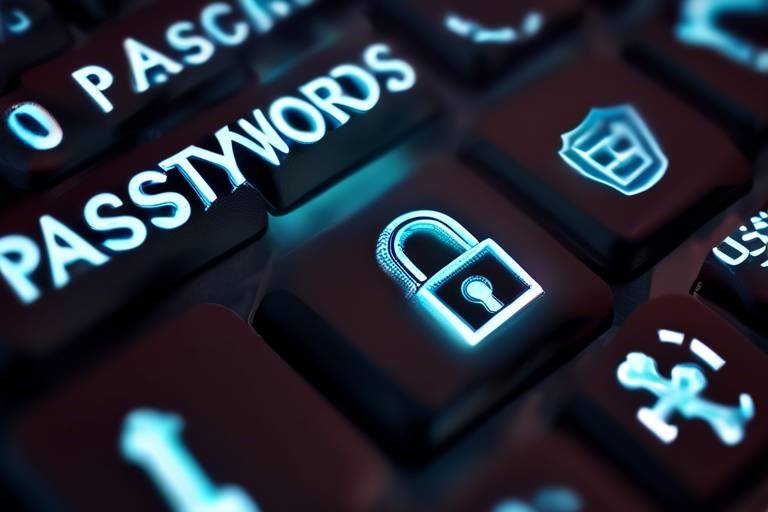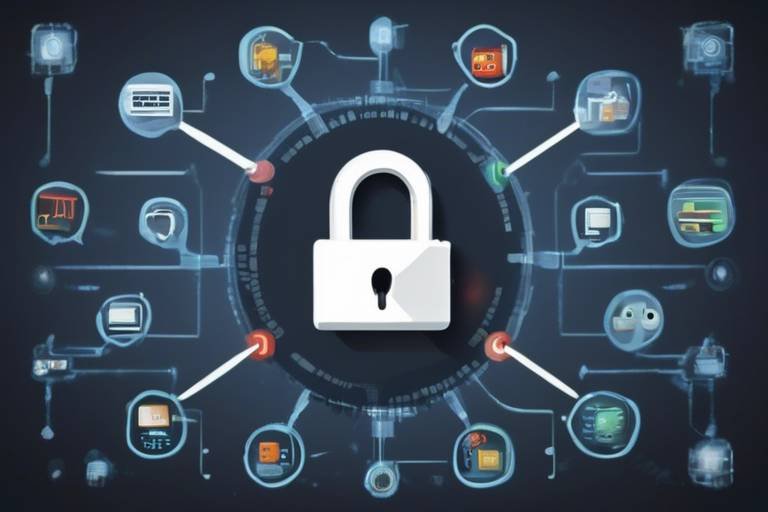The Role of Blockchain in Protecting Personal Data
In today's digital age, where personal data is as valuable as gold, the need for robust security measures has never been more critical. Blockchain technology emerges as a game-changer in this arena, offering innovative solutions to protect personal data from unauthorized access and breaches. Imagine a world where you have complete control over your information, where your data is not just stored but safeguarded with the highest levels of security. This article dives deep into how blockchain enhances personal data security, its advantages over traditional systems, and its potential to empower users in managing their information securely.
At its core, blockchain is a decentralized digital ledger that records transactions across multiple computers. This means that no single entity has control over the entire database, making it nearly impossible for hackers to alter the information without consensus from the network. Each transaction is encrypted and linked to the previous one, creating a chain of blocks that is secure and transparent. This decentralized nature, combined with cryptographic security, is what sets blockchain apart from traditional data storage systems. With personal data increasingly falling prey to cyber attacks, understanding how blockchain operates is crucial for anyone concerned about their data security.
Blockchain technology offers a plethora of benefits when it comes to data protection. Let's look at some of the key advantages:
- Increased Transparency: Every transaction made on a blockchain is visible to all participants, which fosters a sense of trust.
- Immutability: Once data is recorded, it cannot be altered or deleted, ensuring a reliable history of information transactions.
- Enhanced User Control: Users can manage permissions and share their data selectively, giving them more power over their personal information.
The decentralized structure of blockchain significantly reduces single points of failure. In traditional systems, a centralized server can be a prime target for hackers. If compromised, all the data stored on that server is at risk. However, with blockchain, data is distributed across a network of computers. This means that even if one node is attacked, the information remains secure on other nodes. Think of it like a spider web; if one strand is cut, the web remains intact. This inherent security feature makes blockchain an attractive option for protecting personal data.
Another remarkable feature of blockchain is its immutability. Once data is recorded on the blockchain, it cannot be altered or deleted. This provides a reliable history of personal information transactions, which is crucial for accountability. Imagine keeping a diary where every entry is locked in a vault; you can read it, but no one can change what you've written. This quality not only enhances data integrity but also builds trust among users who can be confident that their information remains unchanged.
Blockchain empowers individuals to take control of their data like never before. Users can manage permissions and determine who has access to their information. This level of control is revolutionary in a world where data is often mishandled or exploited. For instance, instead of blindly trusting a company with your data, you can now set specific rules about how and when your information is shared. It’s like having a personal gatekeeper who only lets the right people in.
Smart contracts are another exciting aspect of blockchain technology. These self-executing contracts automate data-sharing agreements, ensuring that all parties comply with privacy regulations. With smart contracts, users can set conditions for data sharing, and the contract will execute automatically when those conditions are met. This not only streamlines processes but also enhances compliance, making it easier for organizations to adhere to regulations like GDPR.
Despite its many advantages, implementing blockchain solutions for personal data protection is not without challenges. Organizations face several obstacles, including scalability, regulatory concerns, and user adoption.
One of the primary challenges is scalability. As the volume of personal data grows, blockchain networks must efficiently handle this data without compromising performance. Imagine trying to fit an entire library's worth of books into a single bookshelf; it just won't work without some creative solutions. Therefore, addressing scalability is crucial for the widespread adoption of blockchain technology.
Another significant hurdle is ensuring that blockchain solutions comply with data protection laws, such as GDPR. Non-compliance can lead to severe penalties for organizations. It's essential for businesses to navigate these regulations carefully to avoid legal ramifications. Think of it as walking a tightrope; one misstep could lead to a fall.
1. What is blockchain technology?
Blockchain is a decentralized digital ledger that records transactions securely across a network of computers.
2. How does blockchain protect personal data?
It enhances data security through decentralization, immutability, and user control, making it difficult for unauthorized access or breaches to occur.
3. What are smart contracts?
Smart contracts are self-executing contracts that automate agreements and ensure compliance with privacy regulations.
4. What challenges does blockchain face?
Key challenges include scalability, regulatory compliance, and user adoption.

Understanding Blockchain Technology
This article explores how blockchain technology enhances personal data security, its advantages over traditional systems, and its potential to empower users in managing their information securely.
Blockchain technology is a revolutionary concept that fundamentally changes how we think about data storage and security. At its core, blockchain is a decentralized digital ledger that records transactions across many computers in such a way that the registered transactions cannot be altered retroactively. This means that once data is entered into the blockchain, it becomes a permanent part of the record. Imagine a public library where every book is a transaction, and once a book is placed on the shelf, it cannot be removed or rewritten. This analogy helps illustrate the immutability of blockchain data.
One of the standout features of blockchain is its cryptographic security. Each block in the chain contains a unique cryptographic hash of the previous block, along with a timestamp and transaction data. This chain of blocks is secured through complex algorithms that make it nearly impossible for anyone to tamper with the data. If a hacker were to attempt to change a single block, they would need to alter every subsequent block in the chain across all distributed copies of the blockchain, which is practically unfeasible. Therefore, this cryptographic backbone provides a robust defense against unauthorized access and breaches.
Furthermore, the decentralized nature of blockchain technology means that there is no single point of failure. Unlike traditional data storage systems that rely on central servers, which can be vulnerable to attacks, blockchain spreads the data across a network of computers. This can be likened to a spider web; if you try to break one strand, the web remains intact because of its interconnectedness. This decentralization enhances security and ensures that personal data remains protected even if one part of the network is compromised.
In addition to these security features, blockchain technology also enhances transparency. Every participant in the network has access to the entire blockchain, which means that all transactions are visible and verifiable. This transparency builds trust among users, as they can independently verify the integrity of the data without relying on a central authority. In a world where data breaches and privacy concerns are rampant, this level of transparency is invaluable.
Overall, understanding blockchain technology is crucial for recognizing its potential in protecting personal data. With its decentralized structure, cryptographic security, and inherent transparency, blockchain provides a powerful alternative to traditional data management systems. As we delve deeper into the benefits of blockchain for data protection, it becomes clear that this technology is not just a trend—it's a transformative force in the realm of personal data security.
This section highlights the key advantages of using blockchain for data protection, such as increased transparency, immutability, and enhanced user control over personal information.
Exploring how the decentralized structure of blockchain reduces single points of failure, making it difficult for hackers to compromise personal data stored on the network.
Discussing how blockchain's immutable ledger ensures that once data is recorded, it cannot be altered or deleted, providing a reliable history of personal information transactions.
Examining how blockchain empowers individuals to have greater control over their data, allowing them to manage permissions and share information selectively.
An introduction to smart contracts and how they can automate data sharing agreements while ensuring compliance with privacy regulations.
Identifying the obstacles that organizations face when integrating blockchain technology for personal data protection, including scalability, regulatory concerns, and user adoption.
Analyzing the challenges related to scaling blockchain networks to handle large volumes of personal data efficiently without compromising performance.
Discussing the importance of ensuring that blockchain solutions comply with data protection laws, such as GDPR, and the implications of non-compliance for organizations.
- What is blockchain technology? - Blockchain is a decentralized digital ledger that records transactions securely and immutably across a network.
- How does blockchain enhance data security? - It uses cryptographic algorithms and decentralization to protect data from unauthorized access and breaches.
- What are smart contracts? - Smart contracts are self-executing contracts with the terms of the agreement directly written into code, automating processes while ensuring compliance.
- What are the challenges of implementing blockchain? - Challenges include scalability, regulatory compliance, and user adoption.

Benefits of Blockchain for Data Protection
In today’s digital landscape, where data breaches and privacy concerns are rampant, the benefits of blockchain technology for protecting personal data cannot be overstated. This revolutionary technology not only enhances security but also transforms the way individuals manage their information. One of the most significant advantages is the increased transparency it offers. With blockchain, every transaction is recorded on a public ledger that anyone can access, making it nearly impossible to manipulate or hide data. This transparency instills a sense of trust among users, as they can verify how their data is being used without relying on third-party intermediaries.
Moreover, blockchain's immutability ensures that once data is entered into the system, it cannot be altered or deleted. This feature is akin to writing in stone; once it's there, it stays there. This is particularly crucial for personal data, as it provides a reliable history of information transactions that can be audited and verified. Imagine trying to erase a permanent marker from a wall; it’s a daunting task, much like trying to alter data on a blockchain. This characteristic not only protects against fraud but also enhances accountability, as any attempt to tamper with the data would be immediately evident.
Another remarkable benefit of blockchain is the enhanced user control it offers. In traditional systems, users often feel like passive participants, relinquishing their data to corporations that dictate how it’s used. However, blockchain flips this narrative on its head. Users can actively manage permissions, deciding who gets access to their information and under what circumstances. This level of control is empowering; it’s like having the keys to your own data vault, allowing you to grant access only to those you trust. Furthermore, with the aid of smart contracts, individuals can automate data sharing agreements, ensuring that their privacy preferences are adhered to without the need for constant oversight.
To illustrate the benefits of blockchain for data protection, let’s look at the following table:
| Benefit | Description |
|---|---|
| Increased Transparency | All transactions are recorded on a public ledger, allowing users to verify data usage. |
| Immutability | Once data is recorded, it cannot be altered or deleted, providing a reliable history. |
| Enhanced User Control | Users can manage permissions and share information selectively, retaining ownership. |
In conclusion, the benefits of blockchain technology for personal data protection are profound. By enhancing transparency, ensuring immutability, and empowering users, blockchain not only secures personal information but also reshapes the relationship between users and their data. As we continue to navigate the complexities of the digital age, embracing these advantages will be crucial in safeguarding our personal information from unauthorized access and breaches.
- What is blockchain technology?
Blockchain is a decentralized digital ledger that records transactions across many computers in a way that the registered transactions cannot be altered retroactively. - How does blockchain enhance data security?
By using cryptographic security and a decentralized structure, blockchain reduces the risk of unauthorized access and data breaches. - Can blockchain be used for personal data management?
Yes, blockchain allows individuals to control their data and manage permissions for who can access it. - What are smart contracts?
Smart contracts are self-executing contracts with the terms of the agreement directly written into code, facilitating automated data sharing while ensuring compliance with privacy regulations.

Decentralization and Security
The concept of decentralization is at the very heart of blockchain technology, and it plays a crucial role in enhancing security for personal data. But what does decentralization really mean? In a traditional centralized system, all data is stored in a single location, such as a server or database. This setup creates a single point of failure; if that server is compromised, all the data it holds is vulnerable. Imagine it like a fortress with one entrance—if an intruder gets in, they can access everything inside. In contrast, blockchain operates on a distributed network where data is replicated across multiple nodes. This means that even if one node is attacked, the rest of the network remains intact, making it significantly more challenging for hackers to gain access to personal information.
Moreover, the decentralized nature of blockchain means that there is no central authority controlling the data. Instead, every participant in the network has a copy of the entire blockchain, which is constantly updated and verified by the community. This creates a trustless environment, where users can interact without needing to rely on a middleman. Each transaction is recorded in a way that is transparent and visible to all participants, which adds an extra layer of security. Since everyone has access to the same information, any attempt to alter or tamper with data can be easily spotted and rejected by the network.
To illustrate this, consider the following analogy: think of a traditional bank where all your money is stored in one vault. If that vault is broken into, your funds are at risk. Now, envision a decentralized system where your funds are spread across numerous vaults in various locations. Even if one vault is compromised, your money in other vaults remains safe. This is the essence of blockchain's decentralized security. It not only protects against unauthorized access but also mitigates the risks associated with data breaches.
Additionally, the use of cryptographic techniques further fortifies the security of personal data in a blockchain system. Every piece of data is encrypted and linked to the previous block, creating a chain of information that is extremely difficult to break. This means that even if someone were to gain access to the network, deciphering the encrypted data would be nearly impossible without the correct cryptographic keys. The combination of decentralization and cryptographic security makes blockchain a robust solution for protecting personal data against unauthorized access and breaches.
In conclusion, decentralization not only enhances the security of personal data but also empowers users by giving them more control over their information. With no single point of failure and a transparent, trustless environment, blockchain technology represents a significant advancement in how we approach data protection in our increasingly digital world.
- What is blockchain technology? Blockchain is a decentralized digital ledger that records transactions across many computers in a way that the registered transactions cannot be altered retroactively.
- How does decentralization improve security? By distributing data across multiple nodes, decentralization reduces the risk of a single point of failure and makes it more difficult for hackers to compromise the entire system.
- What are smart contracts? Smart contracts are self-executing contracts with the terms of the agreement directly written into code, allowing for automated execution of agreements while ensuring compliance with privacy regulations.
- Are there challenges to implementing blockchain for data protection? Yes, challenges include scalability issues, regulatory compliance, and ensuring user adoption.

Immutability of Data
The concept of immutability in blockchain technology is one of its most powerful features, and it plays a crucial role in ensuring the integrity and security of personal data. Once a piece of information is recorded on the blockchain, it becomes a permanent part of the ledger, making it nearly impossible to alter or delete. This is akin to writing something in stone; once it’s there, it stays there. This characteristic not only protects against data tampering but also establishes a reliable and verifiable history of all transactions related to personal information.
Imagine a scenario where you share your personal data with various organizations. In traditional systems, these organizations can modify or delete your information at will, leading to potential misuse or manipulation. However, with blockchain, any changes to your data require a consensus among the network participants, ensuring that no single entity can unilaterally alter your information. This decentralized verification process acts as a safeguard against unauthorized changes, providing users with peace of mind.
Furthermore, the immutability of data fosters trust among users and organizations. When individuals know that their data is securely locked away in an immutable ledger, they are more likely to engage with services that utilize blockchain technology. This trust is vital in today’s digital landscape, where data breaches and privacy concerns are rampant. In fact, studies have shown that consumers are more inclined to share their personal information with companies that demonstrate a commitment to data security and transparency.
To illustrate the importance of immutability, consider the following table that highlights the differences between traditional data storage and blockchain technology:
| Feature | Traditional Data Storage | Blockchain Technology |
|---|---|---|
| Data Modification | Can be altered or deleted by authorized users | Cannot be altered or deleted once recorded |
| Data Verification | Requires trust in a central authority | Verified by consensus among network participants |
| Data History | May lack a complete history of changes | Provides a transparent and tamper-proof history of transactions |
In summary, the immutability of data on the blockchain not only enhances security but also empowers users by providing them with a transparent and reliable record of their personal information. This feature is essential in building trust in digital interactions, ultimately leading to a more secure and user-centric approach to data management. As we continue to explore the potential of blockchain technology, its ability to maintain an unalterable record of data will undoubtedly play a pivotal role in shaping the future of personal data protection.
- What is data immutability in blockchain? Data immutability refers to the inability to alter or delete information once it has been recorded on the blockchain, ensuring a permanent and secure record.
- How does immutability enhance data security? It prevents unauthorized changes and provides a reliable history of transactions, making it difficult for malicious actors to manipulate data.
- Can data be updated on the blockchain? While the original data cannot be changed, new data can be added to the blockchain, creating a new entry that reflects any updates.

Enhanced User Control
In the digital age, where personal data is often likened to the new oil, having control over your information is paramount. Blockchain technology revolutionizes this aspect by empowering individuals with unprecedented control over their personal data. Imagine being the owner of your own digital identity, where you decide who gets access to your information and under what circumstances. This level of autonomy is a game changer in the realm of data privacy.
One of the most exciting features of blockchain is its ability to allow users to manage permissions seamlessly. For instance, when you share your information with a service provider, you can set specific conditions on how that data can be used. This is akin to giving someone a key to your house but only allowing them to enter certain rooms. With blockchain, you can revoke access whenever you want, ensuring that your data remains under your control.
Furthermore, blockchain provides a transparent audit trail for all transactions involving your personal data. You can see who accessed your information, when they did it, and what they did with it. This transparency not only builds trust but also holds organizations accountable for handling your data responsibly. It’s like having a security camera that records every time someone enters your house, giving you peace of mind.
Moreover, the use of smart contracts on blockchain platforms enhances this user control even further. These self-executing contracts automate the process of data sharing while ensuring compliance with privacy regulations. For example, when you enter into an agreement to share your data with a company, a smart contract can dictate the terms of use, making sure that the company adheres to your preferences. This automation reduces the chances of human error and reinforces your authority over your personal data.
In summary, the enhanced user control offered by blockchain technology signifies a shift towards a more user-centric approach to data privacy. By allowing individuals to manage their information actively, blockchain not only protects personal data but also fosters a culture of trust and accountability. As we continue to navigate the complexities of the digital world, embracing this technology could very well be the key to safeguarding our most valuable asset—our personal information.

Smart Contracts and Data Privacy
Smart contracts are revolutionizing the way we think about data privacy in the digital age. Imagine a scenario where you no longer have to worry about your personal information being mishandled or misused. With smart contracts, this dream is becoming a reality. These self-executing contracts, with the terms of the agreement directly written into code, allow for automated and secure transactions without the need for intermediaries. This means that when you share your data, it’s done under terms that you control, ensuring that your privacy is respected.
One of the most compelling features of smart contracts is their ability to enforce compliance with privacy regulations automatically. For instance, if you’re sharing sensitive information like your medical records, a smart contract can be programmed to ensure that only authorized parties can access that information. This not only protects your data but also provides a clear audit trail of who accessed it and when. Imagine having a digital guardian that watches over your data while you go about your daily life—this is what smart contracts offer.
Furthermore, smart contracts can be designed to implement granular permissions. You can specify exactly what data can be shared, with whom, and for how long. This level of control is unprecedented in traditional systems where once your data is out there, it’s often difficult to retract or limit its use. With the power of blockchain technology backing smart contracts, you can feel confident that your data remains yours, and you dictate the terms of its use.
However, while the concept of smart contracts is appealing, it’s essential to recognize the need for a robust framework to support their implementation. Organizations must ensure that their smart contracts are not only well-coded but also comply with existing data protection laws, such as the General Data Protection Regulation (GDPR). This means that developers need to work closely with legal experts to create solutions that are both innovative and compliant.
In summary, smart contracts represent a significant advancement in the realm of data privacy. They empower individuals with greater control over their personal information while ensuring compliance with legal frameworks. As we move towards a more digital future, the integration of smart contracts into data protection strategies will be crucial in building trust and security in our online interactions.
- What are smart contracts?
Smart contracts are self-executing contracts with the terms of the agreement directly written into code, allowing for automated and secure transactions.
- How do smart contracts enhance data privacy?
They allow users to control who can access their data and under what conditions, providing a secure way to share information.
- Are smart contracts compliant with data protection laws?
Yes, but they must be designed with compliance in mind, often requiring collaboration between developers and legal experts.
- Can I retract my data once shared through a smart contract?
While smart contracts can specify terms for data sharing, retracting data may depend on the terms set within the contract itself.

Challenges in Implementing Blockchain Solutions
While blockchain technology holds immense potential for enhancing personal data protection, the journey to its widespread implementation is not without its hurdles. Organizations looking to adopt blockchain solutions face several challenges that can hinder their progress. Understanding these obstacles is crucial for stakeholders aiming to leverage the benefits of blockchain in securing personal data.
One of the primary challenges is scalability. Blockchain networks, especially those that utilize proof-of-work consensus mechanisms, can struggle to process large volumes of transactions quickly. As more users join the network and data demands increase, the system can become sluggish, leading to delays in processing transactions. For example, Bitcoin, one of the most well-known blockchain platforms, can only handle approximately seven transactions per second, which pales in comparison to traditional payment systems like Visa, which can process thousands. This limitation poses a significant barrier for organizations that require fast and efficient data handling.
Moreover, the regulatory landscape presents another layer of complexity. As governments worldwide begin to recognize the implications of blockchain technology, they are also striving to create regulations that ensure data protection and privacy. However, the evolving nature of these regulations, such as the General Data Protection Regulation (GDPR) in Europe, can create confusion for organizations. Compliance with such laws is paramount, and failing to adhere to them can lead to severe penalties, tarnishing an organization's reputation. For instance, if a blockchain solution inadvertently exposes personal data, the organization may find itself in legal hot water, facing fines and lawsuits.
In addition to scalability and regulatory issues, there is also the challenge of user adoption. For blockchain solutions to be effective, users must be willing to embrace this new technology. Many individuals and organizations remain skeptical about blockchain, often due to a lack of understanding or familiarity with how it works. Educating users about the benefits and functionalities of blockchain is essential for overcoming this barrier. Furthermore, organizations must provide user-friendly interfaces that simplify the interaction with blockchain systems, ensuring that even those with minimal technical knowledge can navigate them effectively.
In summary, while the potential of blockchain technology to protect personal data is vast, organizations must navigate several challenges, including scalability issues, regulatory compliance, and user adoption, to successfully implement these solutions. Addressing these concerns will require collaboration among stakeholders, including technology providers, regulatory bodies, and end-users, to create a robust framework that supports the secure and efficient use of blockchain for personal data protection.
- What is blockchain technology? Blockchain is a decentralized digital ledger that records transactions across multiple computers, ensuring that the data cannot be altered retroactively without the consensus of the network.
- How does blockchain enhance data security? By decentralizing data storage and using cryptographic techniques, blockchain significantly reduces the risk of unauthorized access and data breaches.
- What are smart contracts? Smart contracts are self-executing contracts with the terms of the agreement directly written into code, allowing for automated and secure data sharing.
- What are the challenges of blockchain implementation? Key challenges include scalability, regulatory compliance, and user adoption, which organizations must address to fully leverage blockchain technology.

Scalability Issues
When it comes to implementing blockchain technology for personal data protection, one of the most significant challenges that organizations face is scalability. Imagine trying to fit a massive ocean of data into a tiny bottle; that’s essentially what scalability issues in blockchain feel like. As the amount of personal data continues to grow exponentially, the traditional blockchain systems often struggle to keep up, leading to performance bottlenecks and increased transaction times. This is particularly concerning for businesses that require real-time data processing and quick access to information.
One of the fundamental characteristics of blockchain is its distributed ledger technology, which inherently means that every transaction needs to be verified by multiple nodes in the network. While this decentralization is a boon for security, it can also hinder speed. For instance, in a public blockchain like Bitcoin, the network can only process a limited number of transactions per second, which pales in comparison to traditional payment systems like Visa that can handle thousands of transactions per second. This discrepancy raises a critical question: how do we ensure that blockchain can scale effectively without sacrificing its core principles of security and decentralization?
To tackle these scalability issues, several solutions are being explored, including:
- Layer 2 Solutions: Technologies like the Lightning Network for Bitcoin aim to create secondary layers on top of the blockchain to facilitate faster transactions.
- Sharding: This involves breaking the blockchain into smaller, more manageable pieces (or shards), allowing multiple transactions to occur simultaneously.
- Consensus Mechanisms: Exploring alternative consensus algorithms, such as Proof of Stake (PoS), can significantly reduce the time and energy required for transaction verification.
Despite these potential solutions, organizations must carefully consider the trade-offs involved. For example, while Layer 2 solutions can enhance speed, they may also introduce additional complexities and potential security vulnerabilities. Moreover, the implementation of sharding requires a fundamental redesign of how data is processed and stored, which could be a daunting task for many existing blockchain networks.
Ultimately, the scalability of blockchain technology is not just a technical challenge; it’s a vital consideration that will determine its adoption in various sectors. If organizations can overcome these hurdles, the potential for blockchain to revolutionize personal data protection becomes not just a possibility but a reality. As we look ahead, it’s essential for developers, businesses, and regulators to collaborate and innovate, ensuring that the incredible benefits of blockchain can be harnessed without compromise.
- What is blockchain scalability?
Scalability in blockchain refers to the ability of the network to handle an increasing amount of transactions without compromising performance or security. - Why is scalability important for blockchain?
Scalability is crucial because it determines how effectively a blockchain can be used in real-world applications, especially those requiring high transaction volumes. - What are some solutions to scalability issues?
Solutions include Layer 2 technologies, sharding, and alternative consensus mechanisms like Proof of Stake.

Regulatory Compliance
When it comes to implementing blockchain solutions for personal data protection, one of the most significant hurdles organizations face is ensuring . With the rapid evolution of technology, laws and regulations surrounding data protection have also become increasingly stringent. The General Data Protection Regulation (GDPR) in Europe is a prime example, establishing strict guidelines on how personal data should be collected, stored, and processed. Organizations must navigate these regulations carefully to avoid hefty fines and legal repercussions.
Blockchain technology, while revolutionary, presents unique challenges in this regard. For instance, the very nature of blockchain—being decentralized and immutable—can conflict with certain aspects of data protection laws. For example, under GDPR, individuals have the right to request the deletion of their personal data. However, once data is recorded on a blockchain, it cannot be altered or deleted. This raises a critical question: How can organizations reconcile the immutable nature of blockchain with the right to be forgotten?
Moreover, organizations must also consider how to manage data subject rights effectively. This includes ensuring that individuals can access their data, rectify inaccuracies, and withdraw consent for data processing. To address these challenges, companies may need to implement additional layers of technology or processes that enable compliance while still leveraging the benefits of blockchain.
To help organizations navigate these regulatory waters, it's essential to establish a clear compliance framework. This framework should include:
- Data Mapping: Understanding what data is stored on the blockchain and how it relates to personal data.
- Consent Management: Implementing systems to manage user consent and preferences regarding data sharing.
- Regular Audits: Conducting audits to ensure ongoing compliance with applicable regulations.
In conclusion, while blockchain technology offers exciting opportunities for enhancing personal data protection, organizations must tread carefully to ensure they remain compliant with existing laws. By proactively addressing these regulatory challenges, businesses can harness the power of blockchain without falling foul of the law.
1. What is regulatory compliance in the context of blockchain?
Regulatory compliance refers to the need for organizations to adhere to laws and regulations governing data protection, such as GDPR, when implementing blockchain technology.
2. How does blockchain's immutability conflict with the right to be forgotten?
Blockchain's immutable nature means that once data is recorded, it cannot be altered or deleted, which can conflict with GDPR's requirement for individuals to request the deletion of their personal data.
3. What steps can organizations take to ensure compliance?
Organizations can ensure compliance by implementing data mapping, consent management systems, and conducting regular audits to monitor adherence to applicable regulations.
Frequently Asked Questions
- What is blockchain technology?
Blockchain technology is a decentralized digital ledger that records transactions across multiple computers in a way that ensures the recorded data cannot be altered retroactively. This makes it incredibly secure and transparent, as all participants in the network can access the same information without the need for a central authority.
- How does blockchain enhance personal data security?
Blockchain enhances personal data security by decentralizing data storage, which reduces the risk of data breaches. Since data is stored across a network of computers rather than in a single location, it becomes significantly harder for hackers to access or manipulate personal information.
- What are the benefits of using blockchain for data protection?
Some of the key benefits of using blockchain for data protection include:
- Increased Transparency: All transactions are visible to authorized users, fostering trust.
- Immutability: Once data is recorded, it cannot be changed or deleted, ensuring a reliable history.
- Enhanced User Control: Individuals can manage their data permissions and share information selectively.
- What are smart contracts, and how do they relate to data privacy?
Smart contracts are self-executing contracts with the terms of the agreement directly written into code. They automate the process of data sharing while ensuring compliance with privacy regulations, making it easier to manage how personal data is accessed and used.
- What challenges do organizations face when implementing blockchain solutions?
Organizations encounter several challenges when integrating blockchain for personal data protection, including:
- Scalability Issues: Ensuring the blockchain can handle large volumes of data without performance degradation.
- Regulatory Compliance: Adhering to data protection laws like GDPR is crucial to avoid legal repercussions.
- User Adoption: Encouraging users to embrace and understand blockchain technology can be difficult.



















